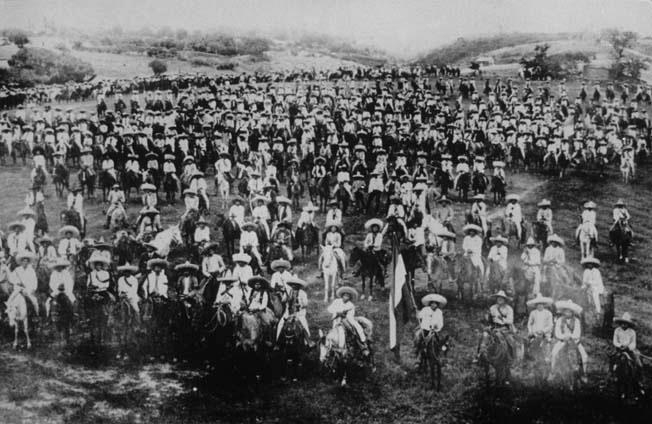|
Zapatismo
Zapatismo is the armed movement identified with the ideas of Emiliano Zapata, leader of the Mexican Revolution, reflected mainly in the Plan of Ayala term 1911. The members of the Liberation Army of the South led by Zapata were known as "Zapatistas". One of the most symbolic phrases of Zapatismo was that the land belongs to the tiller, reflecting a kind of agrarian socialism, originally coined by Zapata himself while trying to remove the chieftaincy in Mexico and restore possession of the land to the peasant classes in the south. The phrase and what it represents became the symbols of Mexican agrarianism. See also * Economic history of Mexico * Index of Mexico-related articles * Neozapatismo * Plan of Ayala The Plan of Ayala (Spanish: ''Plan de Ayala'') was a document drafted by revolutionary leader Emiliano Zapata during the Mexican Revolution. In it, Zapata denounced President Francisco Madero for his perceived betrayal of the revolutionary idea ... * Subcommandante ... [...More Info...] [...Related Items...] OR: [Wikipedia] [Google] [Baidu] |
Neozapatismo
Neozapatismo or neozapatism (sometimes simply Zapatismo) is the political philosophy and practice devised and employed by the Zapatista Army of National Liberation (, EZLN), who have governed a number of communities in Chiapas, Mexico since the beginning of the Chiapas conflict. According to its adherents, it is not an ideology: "Zapatismo is not a new political ideology or a rehash of old ideologies . . . There are no universal recipes, lines, strategies, tactics, laws, rules or slogans. There is only a desire: to build a better world, that is, a new world." As UCL media studies lecturer Anthony Faramelli has written, "Zapatismo is not attempting to inaugurate and/or lead any kind of resistance to neoliberalism, but rather facilitate the meeting of resistance, and allow it to organically form worlds outside of exploitation." Others have proposed a broader conception of neozapatismo that extends beyond the confines of political philosophy and practice. For example, according ... [...More Info...] [...Related Items...] OR: [Wikipedia] [Google] [Baidu] |
Emiliano Zapata
Emiliano Zapata Salazar (; August 8, 1879 – April 10, 1919) was a Mexican revolutionary. He was a leading figure in the Mexican Revolution of 1910–1920, the main leader of the people's revolution in the Mexican state of Morelos, and the inspiration of the agrarian movement called ''Zapatismo''. Zapata was born in the rural village of Anenecuilco in Morelos, in an era when peasant communities came under increasing repression from the small-landowning class who monopolized land and water resources for sugarcane production with the support of dictator Porfirio Díaz (President from 1877 to 1880 and 1884 to 1911). Zapata early on participated in political movements against Díaz and the landowning '' hacendados'', and when the Revolution broke out in 1910 he became a leader of the peasant revolt in Morelos. Cooperating with a number of other peasant leaders, he formed the Liberation Army of the South, of which he soon became the undisputed leader. Zapata's forces contributed to ... [...More Info...] [...Related Items...] OR: [Wikipedia] [Google] [Baidu] |
Agrarianism
Agrarianism is a political and social philosophy that has promoted subsistence agriculture, smallholdings, and egalitarianism, with agrarian political parties normally supporting the rights and sustainability of small farmers and poor peasants against the wealthy in society. In highly developed and industrial nations or regions, it can denote use of financial and social incentives for self-sustainability, more community involvement in food production (such as allotment gardens) and smart growth that avoids urban sprawl, and also what many of its advocates contend are risks of human overpopulation; when overpopulation occurs, the available resources become too limited for the entire population to survive comfortably or at all in the long term. Philosophy Some scholars suggest that agrarianism values rural society as superior to urban society and the independent farmer as superior to the paid worker, and sees farming as a way of life that can shape the ideal social values. It st ... [...More Info...] [...Related Items...] OR: [Wikipedia] [Google] [Baidu] |
Zapatista Army Of National Liberation
The Zapatista Army of National Liberation (, EZLN), often referred to as the Zapatistas (Mexican ), is a far-left political and militant group that controls a substantial amount of territory in Chiapas, the southernmost state of Mexico. Since 1994, the group has been nominally at war with the Mexican state (although it may be described at this point as a frozen conflict). The EZLN used a strategy of civil resistance. The Zapatistas' main body is made up of mostly rural indigenous people, but it includes some supporters in urban areas and internationally. The EZLN's main spokesperson is Subcomandante Insurgente Galeano, previously known as Subcomandante Marcos (a.k.a. Compañero Galeano and Delegate Zero in relation to "the Other Campaign"). Unlike other Zapatista spokespeople, Marcos is not an indigenous Maya. The group takes its name from Emiliano Zapata, the agrarian revolutionary and commander of the Liberation Army of the South during the Mexican Revolution, and sees itse ... [...More Info...] [...Related Items...] OR: [Wikipedia] [Google] [Baidu] |
Liberation Army Of The South
The Liberation Army of the South ( es, Ejército Libertador del Sur, ELS) was a guerrilla force led for most of its existence by Emiliano Zapata that took part in the Mexican Revolution from 1911 to 1920. During that time, the Zapatistas fought against the national governments of Porfirio Díaz, Francisco Madero, Victoriano Huerta, and Venustiano Carranza. Their goal was rural land reform, specifically reclaiming communal lands stolen by hacendados in the period before the revolution. Although rarely active outside their base in Morelos, they allied with Pancho Villa to support the Conventionists against the Carrancistas. After Villa's defeat, the Zapatistas remained in open rebellion. It was only after Zapata's 1919 assassination and the overthrow of the Carranza government that Zapata's successor, Gildardo Magaña, negotiated peace with President Álvaro Obregón. Background The Zapatistas were formed in Morelos, a small and densely populated state with a largely ag ... [...More Info...] [...Related Items...] OR: [Wikipedia] [Google] [Baidu] |
Mexican Revolution
The Mexican Revolution ( es, Revolución Mexicana) was an extended sequence of armed regional conflicts in Mexico from approximately 1910 to 1920. It has been called "the defining event of modern Mexican history". It resulted in the destruction of the Federal Army and its replacement by a revolutionary army, and the transformation of Mexican culture and government. The northern Constitutionalist faction prevailed on the battlefield and drafted the present-day Constitution of Mexico, which aimed to create a strong central government. Revolutionary generals held power from 1920 to 1940. The revolutionary conflict was primarily a civil war, but foreign powers, having important economic and strategic interests in Mexico, figured in the outcome of Mexico's power struggles. The United States played an especially significant role. Although the decades-long regime of President Porfirio Díaz (1876–1911) was increasingly unpopular, there was no foreboding in 1910 that a revolutio ... [...More Info...] [...Related Items...] OR: [Wikipedia] [Google] [Baidu] |
Agrarian Socialism
Agrarian socialism is a political ideology that promotes “the equal distribution of landed resources among collectivized peasant villages” This socialist system places agriculture at the center of the economy instead of the industrialization efforts found in urban settings. Seen as, more progressive in terms of social orientation, many agrarian socialist movements have tended to be rural (with an emphasis on decentralization and non-state forms of collective ownership), locally focused and traditional.The emphasis of agrarian socialists is therefore on social control, ownership and utilization of the means of production (such as farms) in a rural society. Additionally, principles like community, sharing and local ownership are emphasized under agrarian socialism. For instance, in rural communities in Post-Soviet Russia “social organization of labor in the peasant household is based upon highly dense networks of mutual trust and interdependences” that diminished the need ... [...More Info...] [...Related Items...] OR: [Wikipedia] [Google] [Baidu] |
Subcommandante Marcos
Rafael Sebastián Guillén Vicente (born 19 June 1957) is a Mexican insurgent, the former military leader and spokesman for the Zapatista Army of National Liberation (EZLN) in the ongoing Chiapas conflict,Pasztor, S. B. (2004). Marcos, Subcomandante. In D. Coerver, S. Pasztor & R. Buffington, Mexico: An encyclopedia of contemporary culture and history. Santa Barbara, CA: ABC-CLIO and an anti-capitalist and anti-neoliberal globalization icon. Widely known by his initial ''nom de guerre'' Subcomandante Insurgente Marcos (frequently shortened to simply Subcomandante Marcos), he has subsequently employed several other pseudonyms: he called himself Delegate Zero during the Other Campaign (2006–2007), and since May 2014 has gone by the name Subcomandante Insurgente Galeano (again, frequently with the "Insurgente" omitted), which he adopted in honor of his fallen comrade "Teacher Galeano". Marcos bears the title and rank of Subcomandante (or "Subcommander" in English), as opposed to C ... [...More Info...] [...Related Items...] OR: [Wikipedia] [Google] [Baidu] |
Zapatistas
Zapatista(s) may refer to: * Liberation Army of the South The Liberation Army of the South ( es, Ejército Libertador del Sur, ELS) was a guerrilla force led for most of its existence by Emiliano Zapata that took part in the Mexican Revolution from 1911 to 1920. During that time, the Zapatistas foug ..., formed 1910s, a Mexican insurgent group involved in the Mexican Revolution * Zapatista Army of National Liberation (EZLN), formed 1983, a Mexican indigenous armed revolutionary group based in Chiapas * Rebel Zapatista Autonomous Municipalities, autonomous municipalities in Chiapas governed by radical democratic ideals * The ideology of Zapatismo originating in the early 1900s as part of the Mexican Revolution * The ideology of Neozapatismo originating in the late 1900s associated with armed uprisings in Chiapas, Mexico * An oil painting by José Clemente Orozco See also *Emiliano Zapata (1879–1919), Mexican revolutionary {{Disambig ... [...More Info...] [...Related Items...] OR: [Wikipedia] [Google] [Baidu] |
Plan Of Ayala
The Plan of Ayala (Spanish: ''Plan de Ayala'') was a document drafted by revolutionary leader Emiliano Zapata during the Mexican Revolution. In it, Zapata denounced President Francisco Madero for his perceived betrayal of the revolutionary ideals embodied in Madero's Plan de San Luis Potosí, and set out his vision of land reform.Robert P. Millon, "Zapata: The Ideology of a Peasant Revolutionary", International Publishers Co, 1995, pg. 60/ref> The Plan was first proclaimed on November 28, 1911 in the town of Ciudad Ayala, Morelos, Ayala, Morelos, and was later amended on June 19, 1914.Guillermo de la Peña, "A legacy of promises: agriculture, politics and ritual in the Morelos highlands of México", Manchester University Press ND, 1982, pg. 63/ref> The Plan of Ayala was a key document during the revolution and influenced land reform in Mexico during the 1920s and 1930s. It was the fundamental text of the Zapatistas. Background Prior to the Mexican revolution, much of Mexico� ... [...More Info...] [...Related Items...] OR: [Wikipedia] [Google] [Baidu] |
Economic History Of Mexico
Since the colonial era, Mexico's economic history has been characterized by resource extraction, agriculture, and a relatively underdeveloped industrial sector. Economic elites in the colonial period were predominantly Spanish-born, active as transatlantic merchants and mine owners, and diversifying their investments with the landed estates. The largest population sector was indigenous subsistence farmers, which predominantly inhabited the center and south. New Spain was envisioned by the Spanish crown as a supplier of wealth to Iberia, which was accomplished through large silver mines and indigenous labor. A colonial economy to supply foodstuffs and products from ranching as well as a domestic textile industry meant that the economy provided much of its own needs, with international trade mainly conducted through colonial monopolies. Crown economic policies rattled American-born elites’ loyalty to Spain when in 1804, it instituted a policy to make mortgage holders pay immed ... [...More Info...] [...Related Items...] OR: [Wikipedia] [Google] [Baidu] |






.jpg)